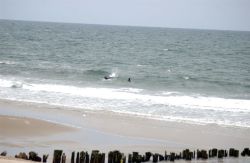Jamaica Bay and the Rockaways
Playground 278
This playground is named for the adjacent J.H.S. 278, also known as the Marine Park School. Marine Park surrounds the westernmost inlet of Jamaica Bay. The bay is one of several formed during the last 5000 years, as ocean currents deposited sand in a series of long strips off the southern shore of Long Island. These strips of beach form a barrier against the surf and allow salt marshes to grow in the calm waters on their protected, bay sides.
At the turn of the 20th century, developers began making elaborate plans to turn Jamaica Bay into a port, dredging Rockaway channel to allow large ships to enter the proposed harbor. Speculators anticipated a real estate boom and bought land along the Jamaica Bay waterfront. Fearing that the relatively pristine marshland around Gerritsen Creek would be destroyed, Frederick B. Pratt and Alfred T. White offered the City 150 acres in the area for use as parkland in 1917.
After a seven-year delay, the City accepted the offer. The prospect of a new park inspired developers to build new homes in the area, although park improvements were slow to follow. Fill deposited in the marshlands in the 1930s, and new land purchases increased the park’s area to 1,822 acres by 1937. That year the Board of Aldermen named the site “Brooklyn Marine Park.” A series of additional land transactions, including the 1974 transfer of 1,024 acres within Marine Park to the National Park Service for inclusion in the Gateway National Recreation Area, have stabilized the area of Marine Park at 798 acres.
Over the past 60 years, portions of Marine Park have been improved with recreational facilities, while other areas have been conserved to protect wildlife and plant life. In 1939 the Pratt-White athletic field was dedicated in tribute to the two fathers of Marine Park. A 210-acre golf course opened in 1963, and the John V. Lindsay Model Airport was dedicated in 1971. New ballfields were opened in 1979 and named for baseball lover and police officer Rocco Torre in 1997. Nature trails established along Gerritsen Creek in 1984-85 invite visitors to observe a wealth of flora and fauna.
Ongoing improvements include the reconstruction of basketball, tennis, and boccie courts; baseball fields; and Lenape Playground at Avenue U. The $4 million Salt Marsh Nature Center, funded by Council Member Herbert Berman and the New York State Environmental Quality Bond Act, opened on June 19, 2000. This beautiful Nature Center serves as both a base of operations for Marine Park’s rangers and workers, and as an educational facility for thousands of children who come to learn about the ecosystem that Marine Park continues to protect.
New York City acquired the land for this playground in 1920, and Parks transferred the property to the Board of Education (BOE) in 1958. The playground opened that same year, jointly operated by BOE and Parks as a facility that would serve both J.H.S. 278 and the surrounding community. Located at the intersection of Stuart Street and Fillmore Avenue inside Marine Park, Playground 278’s circular perimeter is lined with benches, trees, and shrubs, and the park includes play equipment, safety surfacing, a spray shower, and swing sets.
Check out your park's Vital Signs
Clean & Safe
Green & Resilient
Empowered & Engaged Users
Share your feedback or learn more about how this park is part of a
Vital Park System

Know Before You Go
Ecology Park is only open at certain times of year when Parks staff are present in order to protect this unique landscape. Want to visit? Check out our Stewardship Projects page for restoration, planting, and educational events.



